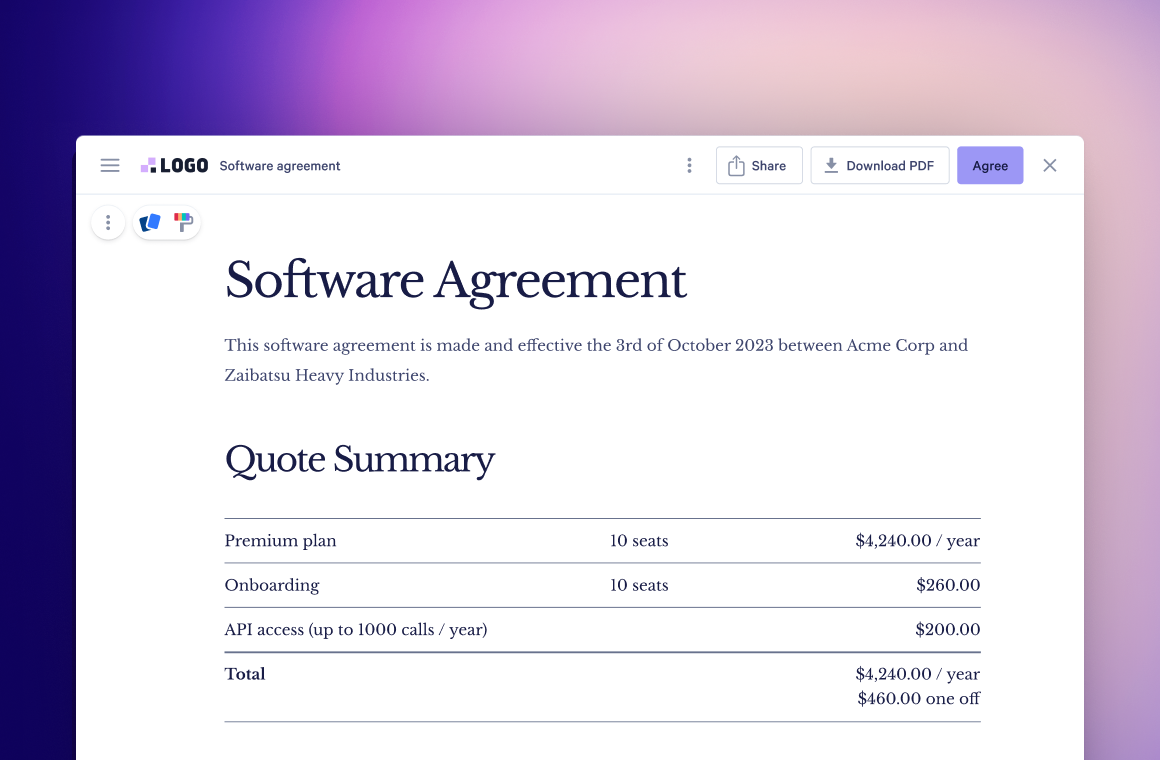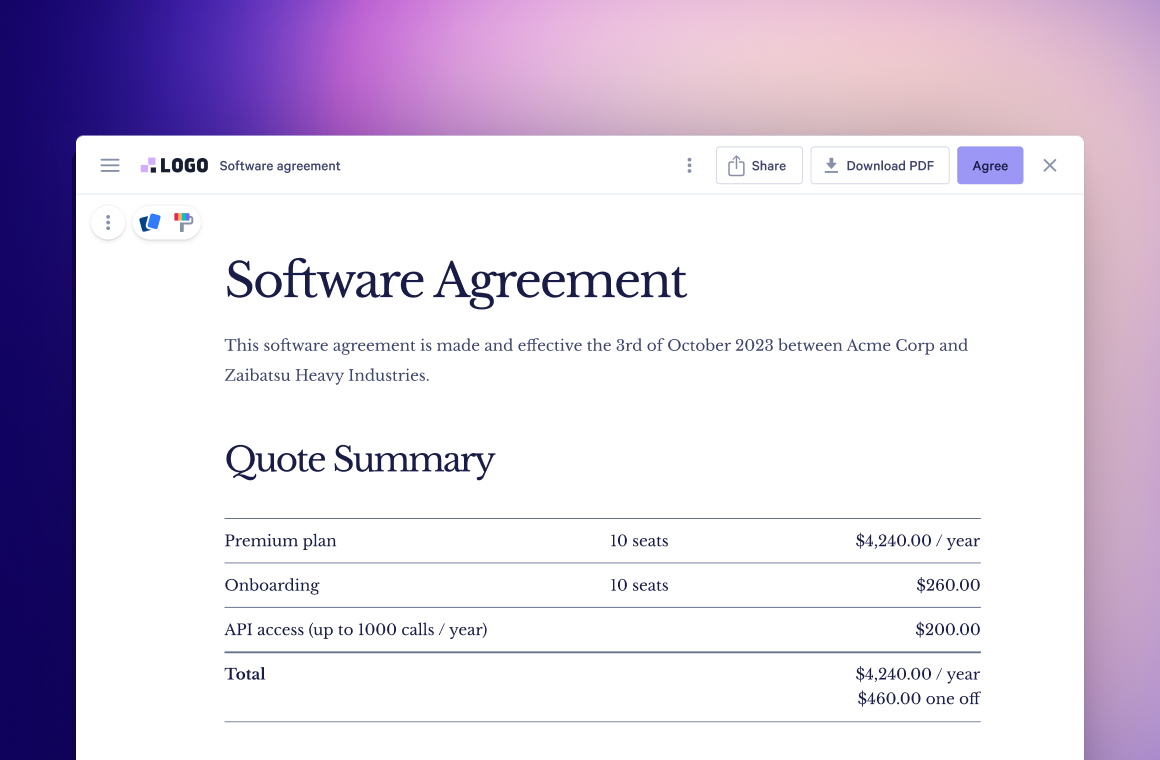Many small business owners, freelancers, and consultants shy away from signing a formal contract, thinking it may push a client deal or overload their time with paperwork.
But here’s the thing: research shows it’s a costly mistake—one that can bleed your business. 58% of businesses experience disputes related to contracts, and it takes an average of 62 days to resolve a contract dispute.
On the other hand, some clients push to have a formal contract to ensure efficient documentation, reducing their sales cycle by 24%.
Either way, whether you're securing a new client relationship or protecting your existing business interests, writing a contract needn’t be a nightmare. In this guide, we’ll share the key components to consider and how to draft effective legal contracts without breaking into a sweat.
Key takeaways
- Contracts are crucial for businesses of all sizes to protect their interests and minimize disputes.
- Key components of a contract include clear identification of parties, deliverables, payment terms, and termination conditions.
- Using contract templates can streamline the drafting process.
- Qwilr offers a convenient way to create, sign, and manage contracts efficiently.
What is a contract, exactly?
A contract is a legally binding agreement between two or more parties that outlines specific obligations, terms, and conditions. While a handshake deal can technically be binding, having everything in writing is like having a clear roadmap for expectations, deadlines, and payment terms—it allows you to focus on what you do best instead of dealing with misunderstandings.
Read next: Proposal vs Contract: What's the Difference?
Do you need special qualifications to write a contract?
While lawyers are essential for complex deals, creating basic business contracts is something every business owner can and should feel confident doing. Think of it like writing detailed instructions—you're simply spelling out what both parties have agreed to, what services or products will be delivered, and how payment will work.
Well-structured contract templates can provide the foundation you need to protect your interests for standard business transactions like consulting projects, service agreements, or freelance work. Just remember to keep the language clear and specific and avoid legal jargon. Of course, when deals get complicated or involve significant risk, bringing in legal expertise makes sense.
Read next: How to Create a Legal Contract Without a Lawyer
Core components of all contracts
A well-crafted contract isn't about using fancy legal jargon—it's about clearly communicating expectations and protecting everyone involved. Below is a table summarizing these key components, along with descriptions and examples of related agreements.
| Inclusion | Description |
|---|---|
Agreement | Specific terms and conditions that outline what each party is obligated to do or refrain from doing under the contract. Examples include a consultant completing work for compensation from a client. |
Consideration | Something of value is exchanged between the parties, such as money, services, or goods. Consideration is essential for making the contract enforceable. For example, payment for services rendered or a trade of goods can serve as consideration. |
Parties | All of the people involved in the agreement. Make sure to include full legal names and addresses of each party (person). |
Intention | The mutual intention of both parties to enter into a legally binding agreement. It ensures that everyone understands and agrees to the terms and conditions. An example here is when a contractor completes work for compensation from a client. |
Terms and Conditions | Each party’s obligations and rights. Clearly defines what each person involved is agreeing to. |
How to draft a contract in 13 simple steps
1. Start with a contract template
Crafting business contracts doesn't mean starting from a blank page when you can lean on contract templates.
Whether you need a marketing contract template, a sales contract template, or a SaaS contract template, we’ve got one that suits your needs. These contracts are already structured with essential elements while being flexible enough for your specific needs, so it’s a win-win.
At Qwilr, we also make it super convenient for businesses to add a variety of formal agreements to their Qwilr pages with an all-in-one proposal and contract management software
To begin, choose from our library of customizable proposal templates, then transition to adding a formal contract or agreement, collect secure payments, and seal the deal with legally binding e-signatures, all in one polished, professional page.
We call this matching beauty with business!
2. Understand the purpose and requirements
Before diving into contract details, get crystal clear on what you're trying to achieve with the agreement. Are you protecting your intellectual property as a consultant, setting project milestones as a freelancer, or establishing service terms as a small business owner? For example, a website project should specify who owns the source code, how many revision rounds are included, and what constitutes billable changes. Diving into the purpose and requirements irons out the expectations and protects all parties involved and should be done not just for immediate needs but also for potential future scenarios
3. Identify all parties involved
When drafting contracts, clearly spell out who’s in the agreement beyond basic company names/ business entity names and addresses. This step establishes clear lines of communication from the start, sealing in who has the authority to make decisions, approve changes, or sign off on deliverables.
For example, in a marketing agency agreement, specify whether the client's Marketing Director alone can approve deliverables or if the CMO's sign-off is required.
4. Outline key terms and conditions
This section of the contract sets the ground rules for what each party can and cannot do, including any exclusivity agreements, confidentiality requirements, or usage rights. When building this section, include specific details about the scope of work, project boundaries, and any constraints or limitations. Another thing to consider is what happens if either party wants to modify these terms during the engagement. For instance, a graphic designer can specify usage rights—whether the client can modify designs internally or must come back to them for changes.
5. Define deliverables and milestones
Determining deliverables and milestones in a contract involves defining exactly what and when you'll provide it.
If you are a consultant, this might mean specifying the number of strategy sessions and written reports. A freelancer can outline the specific project phases and what marks their completion.
The idea is to include clear acceptance criteria for each deliverable so both parties know when something is considered complete and satisfactory.
5. Establish payment terms
Nothing causes more drama with a client than late payments! Invoice after invoice and then crickets! A contract with a payment schedule, therefore, serves as your best defense against payment headaches.So, how do you draft this section in your contract? The best way to do this is to structure your payment terms based on your business model. This could be:
- milestone-based payments (30% upfront, 40% at midpoint, 30% upon completion)
- monthly retainers with net 15 payment terms
- fixed project fees with scheduled installments
Include details about accepted payment methods, late payment penalties, and any early payment incentives to further safeguard your interest. That being said, payment terms are often the trickiest part of any contract, and misunderstandings here can derail even the best projects.
At Qwilr we've made it simple to add a personal touch to your contract proposal payment terms: Include interactive pricing tables and quote blocks, embed a walkthrough video explaining your payment structure using Loom, or add a quick calendar link to discuss terms face-to-face—whatever simplifies the deal closure.

7. Add termination conditions
While this may touch a nerve, adding a termination conditions section to your contract will ensure that you have clear exit strategies in case things start to go south.
To begin with, specify how either party can end the agreement and what happens afterward. A standard 30-day notice period works for ongoing services, but consider shorter windows for project-based work.
To protect your interests, add checkpoints depending on the contract's timelines and immediate termination rights for deal-breakers, breach of contract, or non-payment.
8. Incorporate dispute resolution
No business owner begins a client relationship with a dispute in mind, but they are far more common than you think.
These need to be structured like a ladder—starting with an informal discussion/ good faith meeting with the immediate team lead, escalating to seniors if not resolved, and potentially moving to mediation before considering legal action.
It’s also important to specify which state's laws govern the agreement and whether you'll use arbitration or traditional court proceedings if needed.
9. Address liability and indemnity
As a consultant or freelancer, your expertise is valuable—but it shouldn't put your personal assets at risk. Imagine you recommend a marketing strategy that doesn't meet your client's sales expectations—without proper liability limits, they could try to hold you responsible for their entire revenue shortfall.
Here's how to protect yourself: First, cap your financial risk with clear numbers. Next, spell out what you're not responsible for, such as "Consultant provides recommendations based on expertise and market analysis but cannot guarantee specific business outcomes or ROI."
Finally, protect yourself from third-party issues with language like "Client is responsible for any claims arising from the implementation of consulting recommendations or use of client-provided materials."
Think of it this way: you're offering your expertise, not a guarantee, and your contract should reflect that.
10. Include boilerplate clauses
While often skimmed over as 'standard text', boilerplate clauses are your contract's safety net in unexpected situations. Think of them as your business insurance policy – they might seem unnecessary until you really need them.
Here's what you shouldn't skip:
Force Majeure: This clause protects you when events beyond your control impact your ability to deliver:
- Pandemics and public health emergencies
- Cyber attacks and system outages
- Supply chain disruptions
- Government actions or regulations
Assignment rights: This clause specifies who has the power to pass contract rights to others.
- Whether clients can transfer the contract to another company
- If you can subcontract or delegate work
- What happens in case of company acquisition or merger
- Requirements for written notice and approval
- Conditions for permitted transfers
Severability: This clause ensures that if any provision of the contract is found to be invalid or unenforceable:
- The entire agreement doesn't fail if one clause is challenged
- Allows courts to remove invalid provisions while keeping the rest intact
- Protects core business terms even if standard clauses are disputed
Non-Waiver Clause: This clause protects your right to enforce terms, regardless of past enforcement decisions
- Clarifies that not enforcing a term once doesn't mean you can't enforce it later
- Maintains your contract rights even if you show flexibility
- Requires written agreement for any permanent changes
Read next: How to write an addendum to a contract
11. Review and edit
Now that you’ve done most of the heavy lifting, it’s time for the final polish. Review your client contract thoroughly, ensuring all sections align with your business needs and legal requirements.
Read through key sections such as pricing and deliverables. Double-check that termination clauses protect you from scope creep and provide clear exit paths if needed.
Read next: Amendments vs addendums
12. Streamline signing
Make closing the deal friction-free. Consider this flow: contract review, online signature creation, and immediate invoice generation for the first payment – all in one seamless process. For high-value agreements, build in a brief video call to walk through key terms together before signing, reducing the risk of misunderstandings.
Qwilr’s electronic signatures are easy to add and legally binding, which significantly speeds up the contract finalization process. Not to mention our built-in Stripe integration, which makes it easy for clients to pay deposits and full payments, streamlining the entire process.

Win over your buyer with compelling collateral, outline your offer in a plain-text agreement and seal the deal with an e-signature — all with Qwilr
13. Store and track contracts
The last step to good contract management is ensuring that you aren’t digging through email threads or shared drives searching for something crucial in the contract. With our solution, a complete audit trail tracks every interaction, from client views ( through our document analysis) to signature timestamps, creating an ironclad record of every agreement.
The best part? All of the above information is organized in a clean, simple timeline on your dashboard and is also available in PDF format.
Capture the important signatures with Qwilr
Running a business is complex enough, and as a business owner, you're already wearing multiple hats—and we know that managing contracts can feel like one too many.
With Qwilr, you can turn the traditional hassle of paperwork into one smooth journey that looks as professional as your work. One beautiful page complete with contracts, one seamless process, and one place to track it all. Sign up for a free trial to experience how you can do client onboarding right, letting you get back to what you love doing most.
About the author

Brendan Connaughton|Head of Growth Marketing
Brendan heads up growth marketing and demand generation at Qwilr, overseeing performance marketing, SEO, and lifecycle initiatives. Brendan has been instrumental in developing go-to-market functions for a number of high-growth startups and challenger brands.



